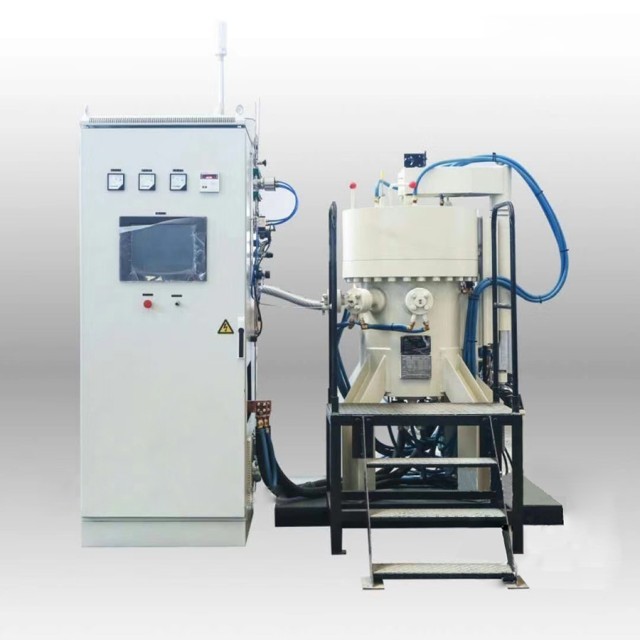
Vacuum Furnace
9MPa Air Pressure Vacuum Heat Treat and Sintering Furnace
Item Number : KT-APS
Price varies based on specs and customizations
- Maximum pressure
- 1.2MPa~9MPa
- Temperature
- 2000℃~2200℃
- Cold vacuum degree
- 10^-3Pa~10Pa
Shipping:
Contact us to get shipping details Enjoy On-time Dispatch Guarantee.
Why Choose Us
Reliable PartnerEasy ordering process, quality products, and dedicated support for your business success.
Advanced Air Pressure Sintering Furnace for High-Performance Ceramics
Achieve superior densification and strength in your advanced ceramic materials with KINTEK's Air Pressure Sintering Furnace. This cutting-edge equipment expertly combines vacuum and pressure sintering techniques, delivering exceptional results for demanding applications.
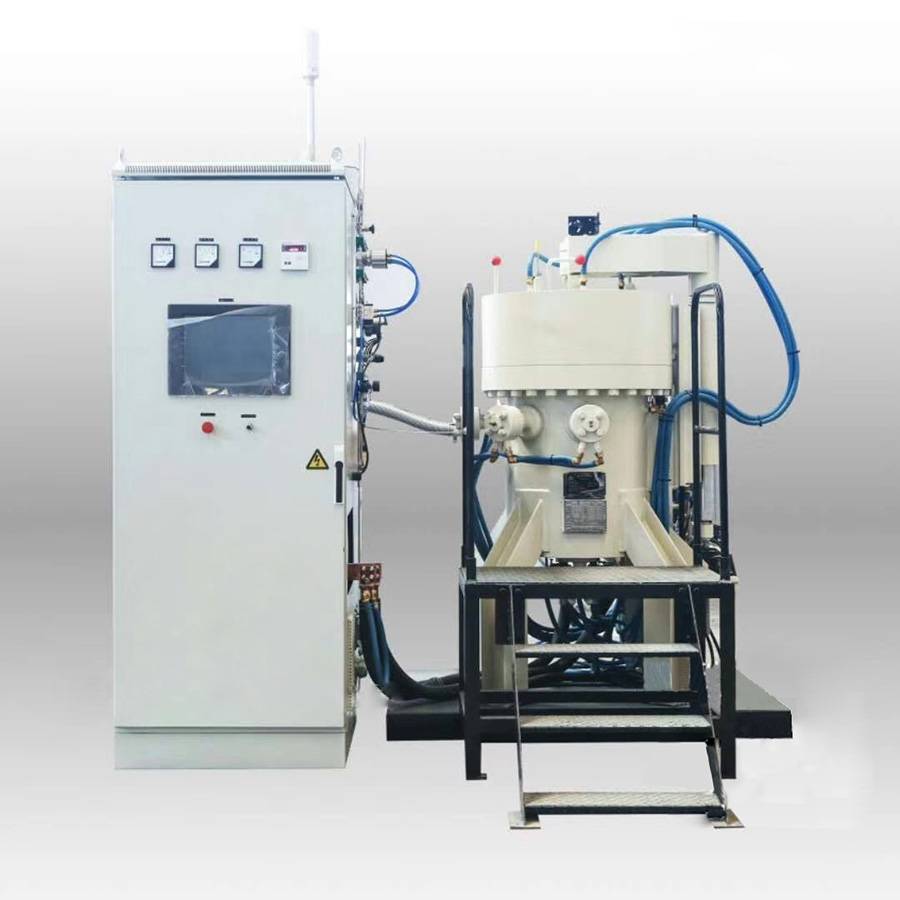
Key Capabilities at a Glance:
- High Pressure Operation: Capable of pressures up to 9MPa for effective densification of ceramic materials.
- Precision Temperature Control: Achieves temperatures up to 2200℃ with accurate and uniform heating.
- Advanced Vacuum System: Reaches a cold vacuum degree of 10-3Pa, ensuring an optimal oxygen-free sintering environment.
- Controlled Sintering Atmosphere: Allows for the introduction of specific gases (e.g., Nitrogen, Argon) to tailor the sintering process.
- Versatile Configurations: Available in vertical, horizontal, and bottom-up designs to accommodate various sample sizes and experimental needs.
Technical Specifications
| Air pressure sintering furnace | Vertical structure |
| The working area | Φ100×90mm, Φ200×220mm, etc. |
| The bottom-lift type | Φ300×400mm, etc. |
| The horizontal type | 250×250×400mm, 375×375×475mm, etc. |
| Cold vacuum degree | 10-3Pa, 10Pa, etc |
| Maximum pressure | 1.2MPa, 2MPa, 6MPa, 9MPa |
| Temperature | 2000℃-2200℃ |
Why Choose KINTEK's Air Pressure Sintering Furnace?
Engineered for Performance and Reliability:
- Superior Temperature Uniformity: Multiple independent heaters and optimized power distribution ensure consistent temperature throughout the high-pressure heating zone, promoting uniform sintering and repeatable results.
- Rapid Processing Cycles: High heating and cooling rates significantly reduce sintering time, boosting productivity and energy efficiency.
- Comprehensive Safety Systems: Operate with confidence thanks to advanced safety measures, including automatic locking for door operations, precise temperature and pressure regulation, and emergency pressure release valves for power failure scenarios.
- Meticulous System Monitoring: The cooling water system is continuously monitored for pressure, temperature, and flow, with individual circuit monitoring to prevent equipment damage from water shortages.
- User-Friendly Operation: Designed with an intuitive interface, making it accessible for operators of various skill levels.
Versatile Applications Across Industries:
Our Air Pressure Sintering Furnaces are ideal for:
- Vacuum sintering and pressure sintering of SiC and Si3N4 ceramic parts
- Critical components for the aerospace and automotive industries
- High-purity materials for medical and dental applications
- Advanced materials research and development in laboratories
Operating Principle
The air pressure sintering furnace utilizes a synergistic combination of high temperature and high pressure to densify ceramic materials. The core components include a heating chamber, a robust pressure vessel, a gas supply system, and a precise temperature control system. During operation, the furnace is heated to a predetermined temperature, after which a high-pressure gas (typically nitrogen or argon) is introduced into the pressure vessel. This applied pressure compresses the ceramic powder, promoting grain growth and significantly enhancing densification. This process results in materials with improved mechanical properties, such as increased strength and hardness, and reduced porosity. Our furnaces are suitable for a variety of ceramic materials, including silicon carbide (SiC), silicon nitride (Si3N4), and zirconia (ZrO2).
Your Partner for Advanced High-Temperature Solutions
Leveraging exceptional R&D and in-house manufacturing, KINTEK provides diverse laboratories with advanced high-temperature furnace solutions. Our product line, including Muffle, Tube, Rotary Furnaces, Vacuum & Atmosphere Furnaces, and CVD/PECVD/MPCVD Systems, is complemented by our strong deep customization capability to precisely meet unique experimental requirements.
Ready to elevate your ceramic sintering capabilities or discuss a custom solution? Our experts are here to help you find the perfect furnace configuration for your specific needs.
Contact us today for a consultation or quote! Click here to get in touch or fill out the form below.
FAQ
What Is The Principle Of A Hot Press Furnace?
What Are The Main Applications Of A Vacuum Furnace?
What Is An Atmosphere Furnace Used For?
What Is A Dental Furnace Used For?
What Are The Applications Of A Hot Press Furnace?
What Are The Key Features Of A Vacuum Furnace?
What Are The Key Features Of An Atmosphere Furnace?
What Are The Key Features Of A Dental Furnace?
What Are The Features Of A Hot Press Furnace?
How Does A Vacuum Furnace Work?
How Does An Atmosphere Furnace Work?
How Does A Dental Furnace Work?
Why Is A Vacuum Environment Used In Hot Press Furnaces?
What Are The Advantages Of Using A Vacuum Furnace?
What Are The Advantages Of Using An Atmosphere Furnace?
What Are The Advantages Of Using A Dental Furnace?
What Materials Are Commonly Processed In Hot Press Furnaces?
What Types Of Materials Can Be Processed In A Vacuum Furnace?
What Types Of Gases Can Be Used In An Atmosphere Furnace?
What Safety Features Should A Dental Furnace Have?
What Is The Difference Between Hot Wall And Cold Wall Vacuum Furnaces?
What Safety Features Are Available In Advanced Atmosphere Furnaces?
What Types Of Dental Furnaces Are Available?
Can Vacuum Furnaces Be Customized For Specific Applications?
4.9
out of
5
Incredible precision and durability! This furnace outperforms competitors effortlessly.
4.8
out of
5
Fast delivery and top-notch quality. Worth every penny for advanced heat treatment.
4.7
out of
5
The 9MPa pressure capability is a game-changer. Highly recommend for industrial use.
4.9
out of
5
Exceptional build and performance. Our lab’s efficiency has skyrocketed since installation.
4.8
out of
5
Reliable and advanced—perfect for high-pressure sintering. No regrets!
4.9
out of
5
Cutting-edge technology meets robust design. A must-have for serious metallurgists.
4.7
out of
5
Superior vacuum heat treatment results. Delivered faster than expected!
4.8
out of
5
Unmatched value for money. The furnace handles extreme conditions flawlessly.
4.9
out of
5
Precision engineering at its finest. Our production quality has never been better.
4.7
out of
5
Efficient and durable—exactly what we needed for our research facility.
4.8
out of
5
The 9MPa feature is revolutionary. Seamless operation and minimal maintenance.
4.9
out of
5
A technological marvel! Delivered on time and exceeded all expectations.
4.7
out of
5
Perfect balance of speed and precision. Ideal for high-stakes applications.
4.8
out of
5
Robust and reliable—this furnace is a powerhouse for advanced materials processing.
4.9
out of
5
Exceptional craftsmanship and performance. A standout in its class.
4.7
out of
5
Fast setup and incredible results. The 9MPa pressure is a game-changer.
4.8
out of
5
Worth the investment! Delivers consistent, high-quality results every time.
REQUEST A QUOTE
Our professional team will reply to you within one business day. Please feel free to contact us!
Related Products

600T Vacuum Induction Hot Press Vacuum Heat Treat and Sintering Furnace
600T Vacuum Induction Hot Press Furnace for precise sintering. Advanced 600T pressure, 2200°C heating, vacuum/atmosphere control. Ideal for research & production.
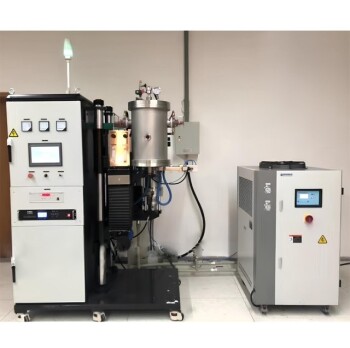
Vacuum Heat Treat Sintering Furnace Molybdenum Wire Vacuum Sintering Furnace
KINTEK's Vacuum Molybdenum Wire Sintering Furnace excels in high-temperature, high-vacuum processes for sintering, annealing, and material research. Achieve precise 1700°C heating with uniform results. Custom solutions available.

Small Vacuum Heat Treat and Tungsten Wire Sintering Furnace
Compact vacuum tungsten wire sintering furnace for labs. Precise, mobile design with superior vacuum integrity. Ideal for advanced material research. Contact us!

Vacuum Heat Treat Sintering and Brazing Furnace
KINTEK Vacuum Brazing Furnaces deliver precision, clean joints with superior temperature control. Customizable for diverse metals, ideal for aerospace, medical, and thermal applications. Get a quote!

Vacuum Heat Treat Furnace with Ceramic Fiber Liner
KINTEK's Vacuum Furnace with Ceramic Fiber Lining offers precise high-temperature processing up to 1700°C, ensuring uniform heat distribution and energy efficiency. Ideal for labs and production.

Molybdenum Vacuum Heat Treat Furnace
High-performance molybdenum vacuum furnace for precise 1400°C heat treatment. Ideal for sintering, brazing, and crystal growth. Durable, efficient, and customizable.

Vacuum Heat Treat Sintering Furnace with Pressure for Vacuum Sintering
KINTEK's Vacuum Pressure Sintering Furnace offers 2100℃ precision for ceramics, metals, and composites. Customizable, high-performance, and contamination-free. Get a quote now!

Vacuum Hot Press Furnace Machine Heated Vacuum Press Tube Furnace
Discover KINTEK's advanced Vacuum Tube Hot Press Furnace for precise high-temperature sintering, hot pressing, and material bonding. Customizable solutions for labs.

2200 ℃ Tungsten Vacuum Heat Treat and Sintering Furnace
2200°C Tungsten Vacuum Furnace for high-temperature materials processing. Precise control, superior vacuum, customizable solutions. Ideal for research & industrial applications.

Mesh Belt Controlled Atmosphere Furnace Inert Nitrogen Atmosphere Furnace
KINTEK Mesh Belt Furnace: High-performance controlled atmosphere furnace for sintering, hardening & heat treatment. Customizable, energy-efficient, precise temperature control. Get a quote now!

1200℃ Controlled Inert Nitrogen Atmosphere Furnace
KINTEK 1200℃ Controlled Atmosphere Furnace: Precision heating with gas control for labs. Ideal for sintering, annealing, and material research. Customizable sizes available.

1400℃ Controlled Inert Nitrogen Atmosphere Furnace
KT-14A Controlled Atmosphere Furnace for labs & industry. 1400°C max temp, vacuum sealing, inert gas control. Customizable solutions available.

1700℃ Controlled Inert Nitrogen Atmosphere Furnace
KT-17A Controlled Atmosphere Furnace: Precise 1700°C heating with vacuum & gas control. Ideal for sintering, research & material processing. Explore now!

Controlled Inert Nitrogen Hydrogen Atmosphere Furnace
Discover KINTEK's Hydrogen Atmosphere Furnace for precise sintering & annealing in controlled environments. Up to 1600°C, safety features, customizable.
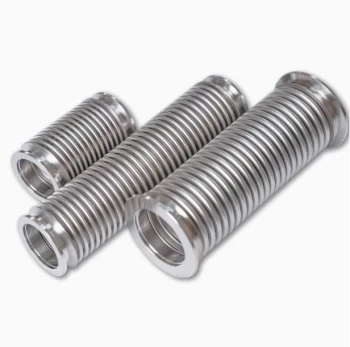
High Performance Vacuum Bellows for Efficient Connection and Stable Vacuum in Systems
KF ultra-high vacuum observation window with high borosilicate glass for clear viewing in demanding 10^-9 Torr environments. Durable 304 stainless steel flange.

Spark Plasma Sintering SPS Furnace
Discover KINTEK's advanced Spark Plasma Sintering (SPS) Furnace for rapid, precise material processing. Customizable solutions for research and production.
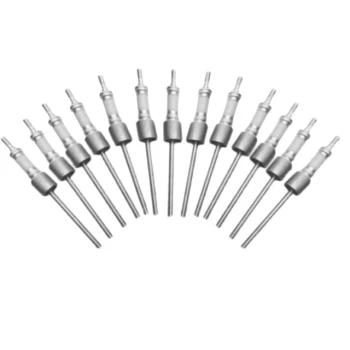
Ultra Vacuum Electrode Feedthrough Connector Flange Power Lead for High Precision Applications
Ultra-Vacuum Electrode Feedthroughs for reliable UHV connections. High-sealing, customizable flange options, ideal for semiconductor & space applications.

CF KF Flange Vacuum Electrode Feedthrough Lead Sealing Assembly for Vacuum Systems
Reliable CF/KF flange vacuum electrode feedthrough for high-performance vacuum systems. Ensures superior sealing, conductivity & durability. Customizable options available.
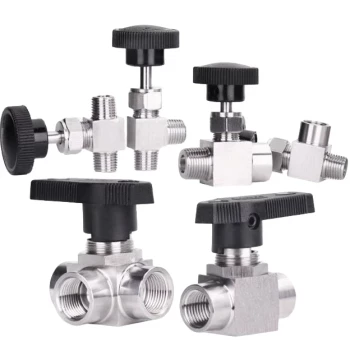
304 316 Stainless Steel High Vacuum Ball Stop Valve for Vacuum Systems
KINTEK's 304/316 stainless steel vacuum ball valves and stop valves ensure high-performance sealing for industrial and scientific applications. Explore durable, corrosion-resistant solutions.
Related Articles

The Microwave Sintering Trap: Why the 'Best' Furnace Might Be the Wrong Choice for Your Lab
Is microwave sintering always the best choice? Discover the hidden costs and learn a smarter way to select the right high-temperature furnace for your lab.

Why Your High-Purity Metal Distillation Fails: The Crucible Contamination You Can’t See
Frustrated by inconsistent metal purity? Discover the hidden chemical reaction in your crucible that's sabotaging your results and how to solve it.